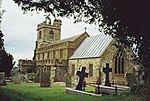Waddon Hill
Archaeological sites in DorsetHills of DorsetHistory of DorsetRoman fortifications in EnglandRoman legionary fortresses in England

Waddon Hill is a hill and the site of an old Roman fort near Beaminster, in the English county of Dorset. The name Waddon is from the Old English meaning wheat hill. The Wessex Ridgeway passes to the north of the hill summit and Roman fort. The B3162 road passes close to the western end of the hill. Lewesdon Hill is about 0.6 miles (1 km) to the west. There is no public right of way on the summit of Waddon Hill, although the hill was frequently walked by locals for centuries, until a change of ownership in the 21st century.
Excerpt from the Wikipedia article Waddon Hill (License: CC BY-SA 3.0, Authors, Images).Waddon Hill
Norway Lane,
Geographical coordinates (GPS) Address Website External links Nearby Places Show on map
Geographical coordinates (GPS)
| Latitude | Longitude |
|---|---|
| N 50.8104 ° | E -2.78625 ° |
Address
Waddon Hill (Roman Fort)
Norway Lane
DT8 3JS , Stoke Abbott
England, United Kingdom
Open on Google Maps










